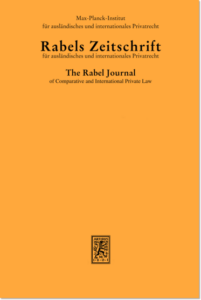RabelsZ: New issue alert
 The latest issue of RabelsZ has just been released. It contains the following contributions:
The latest issue of RabelsZ has just been released. It contains the following contributions:
OBITUARY
Eva-Maria Kieninger, Ralf Michaels: Jürgen Basedow * 29.9.1949 † 6.4.2023, pp. 229–235, DOI: 10.1628/rabelsz-2023-0051
ESSAYS
Felix Berner: Implizite Qualifikationsvorgaben im europäischen Kollisionsrecht, pp- 236–263, DOI: 10.1628/rabelsz-2023-0028
Implicit Characterization in European Conflict of Laws. – Most German scholars assume that problems of characterization in European choice of law are to be resolved by means of functional characterization. This essay challenges that assumption. Quite often, European choice-of-law rules themselves require a certain treatment of a characterization problem. This can follow from the rules or recitals of European regulations. In such cases, the required approach is more or less explicitly given. However, the required analysis can also be implicitly established, especially when it is derived from the purpose of certain choice-of-law rules. The approach towards characterization is of both practical and theoretical significance. In practice it determines the outcome of a characterization inquiry. On a theoretical level, the approach towards characterization embodies a conceptual change: The more rules on characterization there are, the more the classic problem of characterization is marginalized. Questions of characterization turn into questions of “simple statutory interpretation”.
Frederick Rieländer: Die Anknüpfung der Produkthaftung für autonome Systeme, pp. 264–305, DOI: 10.1628/rabelsz-2023-0032
The Private International Law of Product Liability and AI-related Harm. – As the EU moves ahead with extensive reform in all matters connected to artificial intelligence (AI), including measures to address liability issues regarding AI-related harm, it needs to be considered how European private international law (PIL) could contribute to the EU’s objective of becoming a global leader in the development of trust-worthy and ethical AI. To this end, the article examines the role which might be played in this context by the conflict-of-law rule concerning product liability in Article 5 of the Rome II Regulation. It shows that the complex cascade of connecting factors in matters relating to product liability, although providing legal certainty for market players, fails to consistently support the EU’s twin aim of promoting the up-take of AI, while ensuring that injured persons enjoy the same level of protection irrespective of the technology employed. Assessing several options for amending the Rome II Regulation, the article calls for the introduction of a new special rule concerning product liability which allows the claimant to elect the applicable law from among a clearly defined number of substantive laws. Arguably, this proposal offers a more balanced solution, favouring the victim as well as serving the EU’s policies.
Tim W. Dornis: Künstliche Intelligenz und internationaler Vertragsschluss, pp. 306–325, DOI: 10.1628/rabelsz-2023-0043
Artificial Intelligence and International Contracting. – Recently, the debate on the law applicable to a contract concluded by means of an AI system has begun to evolve. Until now it has been primarily suggested that the applicable law as regards the “legal capacity”, the “capacity to contract” and the “representative capacity” of AI systems should be determined separately and, thus, that these are not issues falling under the lex causae governing the contract. This approach builds upon the conception that AI systems are personally autonomous actors – akin to humans. Yet, as unveiled by a closer look at the techno-philosophical foundations of AI theory and practice, algorithmic systems are only technically autonomous. This means they can act only within the framework and the limitations set by their human users. Therefore, when it comes to concluding a contract, AI systems can fulfill only an instrumental function. They have legal capacity neither to contract nor to act as agents of their users. In terms of private international law, this implies that the utilization of an algorithmic system must be an issue of contract conclusion under art. 10 Rome I Regulation. Since AI utilization is fully subject to the lex causae, there can be no separate determination of the applicable law as regards the legal capacity, the capacity to contract or representative capacity of such systems.
Peter Kutner: Truth in the Law of Defamation, pp. 326–352, DOI: 10.1628/rabelsz-2023-0038
This article identifies and examines important aspects of truth as a defence to defamation liability in common law and “mixed” legal systems. These include the fundamental issue of what must be true to establish the defence, whether the defendant continues to have the burden of proving that a defamatory communication is true, the condition that publication must be for the public benefit or in the public interest, “contextual truth” (“incremental harm”), and the possibility of constitutional law rules on truth that are different than common law rules. The discussion includes the emergence of differences among national legal systems in the operation of the truth defence and evaluation of the positions that have been adopted.
BOOK REVIEWS
As always, this issue also contains several reviews of literature in the fields of private international law, international civil procedure, transnational law, and comparative law (pp. 353–427).


